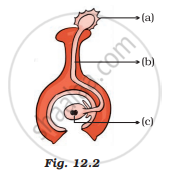Advertisements
Advertisements
प्रश्न
Name the three types of asexual reproduction in unicellular organisms.
उत्तर
- Binary fission
- Multiple fission
- Budding
APPEARS IN
संबंधित प्रश्न
Differentiate between 'stem tuber' and 'tuberous root'.
Draw labelled diagrams to illustrate budding in Hydra.
A student is observing a permanent slide showing sequentially the different stages of asexual reproduction taking place in yeast. Name this process and draw diagrams, of what he observes, in a proper sequence.
Draw a labelled diagram to show that particular stage of binary fission in amoeba in which its nucleus elongates and divide into two and a constriction appears in its cell membrane.
Name the following : 'Blobs' that develop at the tips of the non-reproductive threads in Rhizopus.
How the process of regeneration in Planaria process different from reproduction?
Draw in sequence (showing the four stages), the process of binary fission in Amoeba.
Name the process by which an Amoeba reproduces. Draw the various stages of its reproduction in a proper sequence.
which can be grown from their leaves.
What is the name of asexual reproduction method in Spirogyra
Name one commonly used vegetable which is propagated by using tubers.
Vegetative propagation involves the growth and development of 'something' present in the old part of the plant to form a new plant. What is this 'something'?
Name a tiny fresh-water animal which reproduces by the same method as that of yeast? What is this method known as?
Asexual reproduction through budding takes place in :
(i) Amoeba and Yeast
(ii) Yeast and Hydra
(iii) Hydra and Plasmodium
(iv) Corals and Sponges
(a) (i) and (ii)
(b) only (ii)
(c) (i) and (iii)
(d) (ii) and (iv)
The two organisms which can regenerate fully from their cut body parts are :
(a) Paramecium and Hydra
(b) Hydra and Amoeba
(c) Planaria and Leishmania
(d) Hydra and Planaria
Binary fission describes the type of reproduction where the organism divides to form :
(a) many spores
(b) two daughters
(c) many buds
(d) two hyphae
Define the following:
Vegetative reproduction
Mention the common method of reproduction in Yeast.
Mention the common method of reproduction in Rose.
Mention the common method of reproduction in Mango.
After viewing different slides, a student draws following diagrams. Select the one which depicts binary fission in Amoeba:
 (A) a
(A) a
(B) b
(C) c
(D) d
Following diagrams were drawn by different student on having seen prepared slides of budding in yeast.
Correct diagrams are
(A) I, II, III
(B) II, III, IV
(C) III, IV, V
(D) I, IV, V
What is fragmentation in organisms?
A student was given two permanent slides, one of binary fission in Amoeba and other of budding in yeast. He was asked to identify any one difference in the nucleus of the two. One such difference, he identified correctly was
(1) Presence of one nucleus in Amoeba, two in yeast cell and one in bud.
(2) Presence of two nuclei in centrally constricted Amoeba, one in yeast cell and one in its bud.
(3) Presence of two distant nuclei in Amoeba, one in yeast cell and two in bud.
(4) Presence of a single nucleus each in Amoeba, yeast cell and its attached bud.
Name two flowering plants that reproduce both by seeds and by vegetative means.
Write four lines on the following: Budding
Give the name of the plant that reproduces vegetatively by: Bulbils
What are the objectives of plant hybridisation?
Porogamy refers to entry of pollen tube through ____________.
Define.
Vegetative propagation
Identify the type of reproduction from the following explanation and draw a neat and labelled diagram.
- The body of the parent organism breaks up into many fragments and each fragment starts to live as an independent new organism.
- Give two examples of living organisms which follow this type of reproduction method.
Seeds are the product of asexual reproduction.
Which of the following statements are true for flowers?
- Flowers are always bisexual
- They are the sexual reproductive organs
- They are produced in all groups of plants
- After fertilisation they give rise to fruits
In the diagram given in Figure 12.2 label the parts marked (a), (b) and (c).

Vegetative reproduction of Agave occurs through ______.
Suppose there is one member of a particular kind of organism in a culture dish, which doubles itself in one hour through asexual reproduction. Work out the number of members of that kind of organism which will be present in the culture dish after ten hours. Such a colony of individuals arising from one parent is called a “clone”.
